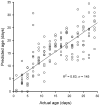Field validation of a transcriptional assay for the prediction of age of uncaged Aedes aegypti mosquitoes in Northern Australia
- PMID: 20186322
- PMCID: PMC2826399
- DOI: 10.1371/journal.pntd.0000608
Field validation of a transcriptional assay for the prediction of age of uncaged Aedes aegypti mosquitoes in Northern Australia
Abstract
Background: New strategies to eliminate dengue have been proposed that specifically target older Aedes aegypti mosquitoes, the proportion of the vector population that is potentially capable of transmitting dengue viruses. Evaluation of these strategies will require accurate and high-throughput methods of predicting mosquito age. We previously developed an age prediction assay for individual Ae. aegypti females based on the transcriptional profiles of a selection of age responsive genes. Here we conducted field testing of the method on Ae. aegypti that were entirely uncaged and free to engage in natural behavior.
Methodology/principal findings: We produced "free-range" test specimens by releasing 8007 adult Ae. aegypti inside and around an isolated homestead in north Queensland, Australia, and recapturing females at two day intervals. We applied a TaqMan probe-based assay design that enabled high-throughput quantitative RT-PCR of four transcripts from three age-responsive genes and a reference gene. An age prediction model was calibrated on mosquitoes maintained in small sentinel cages, in which 68.8% of the variance in gene transcription measures was explained by age. The model was then used to predict the ages of the free-range females. The relationship between the predicted and actual ages achieved an R(2) value of 0.62 for predictions of females up to 29 days old. Transcriptional profiles and age predictions were not affected by physiological variation associated with the blood feeding/egg development cycle and we show that the age grading method could be applied to differentiate between two populations of mosquitoes having a two-fold difference in mean life expectancy.
Conclusions/significance: The transcriptional profiles of age responsive genes facilitated age estimates of near-wild Ae. aegypti females. Our age prediction assay for Ae. aegypti provides a useful tool for the evaluation of mosquito control interventions against dengue where mosquito survivorship or lifespan reduction are crucial to their success. The approximate cost of the method was US$7.50 per mosquito and 60 mosquitoes could be processed in 3 days. The assay is based on conserved genes and modified versions are likely to support similar investigations of several important mosquito and other disease vectors.
Conflict of interest statement
The authors have declared that no competing interests exist.
Figures



Similar articles
-
Use of transcriptional age grading technique to determine the chronological age of Sri Lankan Aedes aegypti and Aedes albopictus females.Parasit Vectors. 2021 Sep 26;14(1):493. doi: 10.1186/s13071-021-04994-x. Parasit Vectors. 2021. PMID: 34565445 Free PMC article.
-
Improved accuracy of the transcriptional profiling method of age grading in Aedes aegypti mosquitoes under laboratory and semi-field cage conditions and in the presence of Wolbachia infection.Insect Mol Biol. 2011 Apr;20(2):215-24. doi: 10.1111/j.1365-2583.2010.01059.x. Epub 2010 Nov 28. Insect Mol Biol. 2011. PMID: 21114562
-
Characterizing the Aedes aegypti population in a Vietnamese village in preparation for a Wolbachia-based mosquito control strategy to eliminate dengue.PLoS Negl Trop Dis. 2009 Nov 24;3(11):e552. doi: 10.1371/journal.pntd.0000552. PLoS Negl Trop Dis. 2009. PMID: 19956588 Free PMC article.
-
Context-specific variation in life history traits and behavior of Aedes aegypti mosquitoes.Front Insect Sci. 2024 Sep 25;4:1426715. doi: 10.3389/finsc.2024.1426715. eCollection 2024. Front Insect Sci. 2024. PMID: 39386346 Free PMC article. Review.
-
Nutritional regulation of vitellogenesis in mosquitoes: implications for anautogeny.Insect Biochem Mol Biol. 2005 Jul;35(7):661-75. doi: 10.1016/j.ibmb.2005.02.013. Epub 2005 Mar 28. Insect Biochem Mol Biol. 2005. PMID: 15894184 Review.
Cited by
-
Transcriptional profiling of Anopheles gambiae mosquitoes for adult age estimation.Insect Mol Biol. 2010 Dec;19(6):745-51. doi: 10.1111/j.1365-2583.2010.01034.x. Insect Mol Biol. 2010. PMID: 20695922 Free PMC article.
-
Reference genes for accessing differential expression among developmental stages and analysis of differential expression of OBP genes in Anastrepha obliqua.Sci Rep. 2016 Jan 28;6:17480. doi: 10.1038/srep17480. Sci Rep. 2016. PMID: 26818909 Free PMC article.
-
Adult survivorship of the dengue mosquito Aedes aegypti varies seasonally in central Vietnam.PLoS Negl Trop Dis. 2014 Feb 13;8(2):e2669. doi: 10.1371/journal.pntd.0002669. eCollection 2014 Feb. PLoS Negl Trop Dis. 2014. PMID: 24551251 Free PMC article.
-
Effects of sample preservation methods and duration of storage on the performance of mid-infrared spectroscopy for predicting the age of malaria vectors.Parasit Vectors. 2022 Aug 6;15(1):281. doi: 10.1186/s13071-022-05396-3. Parasit Vectors. 2022. PMID: 35933384 Free PMC article.
-
The Influence of Diet on the Use of Near-Infrared Spectroscopy to Determine the Age of Female Aedes aegypti Mosquitoes.Am J Trop Med Hyg. 2015 May;92(5):1070-5. doi: 10.4269/ajtmh.14-0790. Epub 2015 Mar 23. Am J Trop Med Hyg. 2015. PMID: 25802436 Free PMC article.
References
-
- Knox TB, Kay BH, Hall RA, Ryan PA. Enhanced vector competence of Aedes aegypti (Diptera: Culicidae) from the Torres Strait compared with mainland Australia for dengue 2 and 4 viruses. J Med Entomol. 2003;40:950–956. - PubMed
-
- Macdonald G. The objectives of residual insecticide campaigns. Trans R Soc Trop Med Hyg. 1952;46:227–235. - PubMed
-
- Garrett-Jones C. Prognosis for interruption of malaria transmission through assessment of the mosquito's vectorial capacity. Nature. 1964;204:1173–1175. - PubMed
-
- Reisen WK. Estimation of vectorial capacity: introduction. Bull Soc Vector Ecol. 1989;14:39–40.
-
- Sinkins SP, O'Neill S L. Wolbachia as a vehicle to modify insect populations. In: Handler AM, James AA, editors. Insect transgenesis: methods and applications. Boca Raton: CRC Press; 2000. pp. 271–287.
Publication types
MeSH terms
LinkOut - more resources
Full Text Sources
Medical

